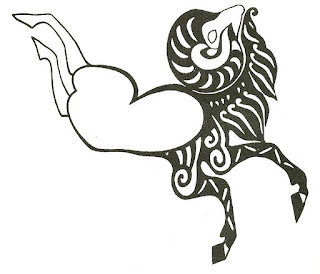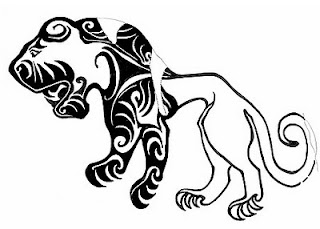 |
| Scythian tattoo of a goat |
Men
Almost the entire adult male Kadiz population has at least one tattoo. This is the heart-sign, or name-sign. It is tattooed on the stomach as part of the ritual when a young man becomes an adult, where it is concealed from view most of the time. This tattoo normally takes the form of a complex polygon (usually a pentagon, hexagon, or octagon) around the navel with a unique design inside it. Often this design will be an animal or a unique geometric configuration of lines and circles. This serves as a representation of the person's name, and is often used as a brand, sigil, and signature to represent the person as needed. A messenger whose trustworthiness or veracity is in question may be asked to describe the name-sign of the person who sent them as a test. Otherwise, this tattoo is covered in public, and someone wandering around with it exposed may be accused of indecency.
 |
| Scythian griffon tattoo |
The next most common types of markings are records of enemies slain, and marriage marks. Kills are recorded in repeating marks on the arms, usually either crosses, lines or chevrons that link up to one another. When a nomad takes a wife, he typically has a picture representing her tattooed somewhere on his body (often the buttocks or inner thighs). Horses, birds, antlers and hearts are all common. If the artist can write, he may even tattoo the name of the woman on, though this is considered somewhat daring as it allows someone else who can read to figure out who the nomad is married to if he is captured.
The third most common are purely decorative marks. These may commemorate nicknames, trades, well-known or meaningful incidents from the person's life, famous ancestors, ritual skill or be simply for aesthetic reasons. More common types include vertical lines from the eyes to jaw, with lines under the left-eye indicating that one is a priest of the Storm Bulls, and lines under the right eye indicating that one is sanctified to the Stone Pack. Tattoos of eyes are common for gnostics, while those sanctified to daimons usually have three black horizontal lines tattooed on their cheeks to warn others. Facial tattoos tend to be simple lines, while those located elsewhere are more complex. The current fashion is for young men to get a dragon or eagle on the collar, while older men will have thorn patterns around their wrists and ankles.
Women
Female tattoos are as common, but less regular than male tattoos, and most are for aesthetic reasons or as a marriage marker. Women who have taken on a male or neuter role in the clan often mimic male tattoo patterns, including a name-sign (which is the nomad equivalent of sporting a false phallus, and about as transgressive if discovered).
Marriage markers on women typically take the form of a thin horizontal line below the navel, with vertical lines intersecting it. The number of horizontal lines indicates how many times she has been married, with the number of vertical lines intersecting each band indicating what priority she had as a wife (so a man's first wife has one line, his second wife has two, etc.). These marks are not normally visible, as nomad women do not expose this part of the body in public, but may be examined by suitors, their mothers and their current wives during negotiations.
The current trends in female decoration are curving lines and rows of small, circular dots. In most cases, the dots and lines are intended to be provocative and sexually suggestive, and the typical design starts somewhere visible in normal clothing and continues in the direction of the buttocks, genitals or breasts, either growing slightly thicker or thinner as it goes. The most enticing are done in a black so thick it can be seen through a woman's underclothes (which are usually a sort of shapeless white sack of thin fabric with arms and leg holes).
A controversial but increasingly more common tattoo with an explicit sexual meaning is known as "the handles" and is two groups of five short lines splayed like fingers on a woman's back above the hips, following her ribs. Originally associated with prostitutes, it conveys an explicit sexual message and demand is growing amongst married women to entice their husbands.
Older women tend to have flowers, petals or birds in blue and black. These start at the neck or shoulders and rain down the body in aesthetically pleasing ways. Another common design involves horses stampeding or charging across the body, and yet another revolves around serpents coiling around the limbs.
Outside of these types of tattoo, women also sport smaller tattoos with the same meanings as men. Mementos of beloved children, trades, skills, origins of nicknames, and famous ancestors are all common. Women sanctified to daimons have the same three black lines tattooed on their faces. Beyond that specific condition, women do not tattoo their faces.
Female tattoos are as common, but less regular than male tattoos, and most are for aesthetic reasons or as a marriage marker. Women who have taken on a male or neuter role in the clan often mimic male tattoo patterns, including a name-sign (which is the nomad equivalent of sporting a false phallus, and about as transgressive if discovered).
Marriage markers on women typically take the form of a thin horizontal line below the navel, with vertical lines intersecting it. The number of horizontal lines indicates how many times she has been married, with the number of vertical lines intersecting each band indicating what priority she had as a wife (so a man's first wife has one line, his second wife has two, etc.). These marks are not normally visible, as nomad women do not expose this part of the body in public, but may be examined by suitors, their mothers and their current wives during negotiations.
The current trends in female decoration are curving lines and rows of small, circular dots. In most cases, the dots and lines are intended to be provocative and sexually suggestive, and the typical design starts somewhere visible in normal clothing and continues in the direction of the buttocks, genitals or breasts, either growing slightly thicker or thinner as it goes. The most enticing are done in a black so thick it can be seen through a woman's underclothes (which are usually a sort of shapeless white sack of thin fabric with arms and leg holes).
A controversial but increasingly more common tattoo with an explicit sexual meaning is known as "the handles" and is two groups of five short lines splayed like fingers on a woman's back above the hips, following her ribs. Originally associated with prostitutes, it conveys an explicit sexual message and demand is growing amongst married women to entice their husbands.
 |
| Scythian tiger tattoo |
Outside of these types of tattoo, women also sport smaller tattoos with the same meanings as men. Mementos of beloved children, trades, skills, origins of nicknames, and famous ancestors are all common. Women sanctified to daimons have the same three black lines tattooed on their faces. Beyond that specific condition, women do not tattoo their faces.

Like how tattoos of the second category are used to record personal achievements. Where did yu get the images from?
ReplyDeleteThe images are "Scythian" tattoos found on "Scythian" bodies in Central Asia. The Pazyryk culture in particular has produced a number of well-preserved bodies showing extensive tattooing, and they were a major influence on the look of the Kadiz.
ReplyDelete